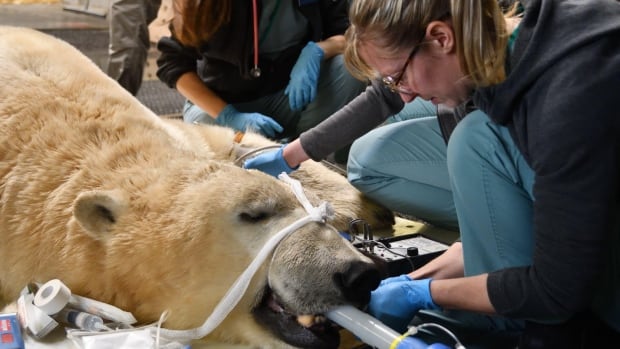Rolling around and lying lazily in the snow of his enclosure at the Quebec City Aquarium, four-year-old Kinuk seems to have recovered from his big trip to the vet in December.
He still shows scars from the medical procedures — notably his shaved stomach and patches on his paws and head where his black skin shows.
Two weeks prior to that journey, staff had noticed a change in Kinuk’s behaviour and a few tremors.
“At the beginning we just tried do some blood sample at the aquarium and monitor his behaviour but we [didn’t] have all the answers we wanted,” said Marie-Pierre Lessard, director of the conservation of the Quebec Aquarium.
Because the aquarium does not have the equipment to perform a number of tests and handle his bulk, they had to hoist him into a truck and head to the province’s only university veterinary facility in Saint-Hyacinthe, some 200 kilometres away.
“The biggest challenge is the weight of Kinuk and the weight of the cage. Because Kinuk is 450 kilos and the cage is the same weight and we have to use a big forklift to move and we have to be really careful because we really don’t want to drop the cage and do some damage [or] hurt Kinuk.”
Limitations to treating ‘most dangerous bears on earth’
Kinuk, who was born in captivity at the Saint-Félicien zoo, did not have to be drugged for the trip because it was relatively easy to convince him to get into his crate.
But once they arrived at the veterinary hospital, the team of vets went to work, said Dr. Noémie Summa, zoological medicine specialist and clinical instructor at the Université de Montréal facility.

They needed enough time to do their tests — without him waking up and objecting.
“It’s a matter of giving him the [right] drugs for him to be able to sleep nicely and so that it’s safe for him, it’s safe for the teams,” said Summa.
“It’s a very big team effort. So we had a lot of specialized people like anesthesia service, neurology, clinical pathology.”
She notes that Kinuk’s symptoms could have indicated a neurological condition or just general weakness — something that is not easy to assess when a large predator is awake.

“It’s hard because you cannot really touch them when they are awake.… He’s a very good bear, but there are limitations,” said Summa.
“They are like the most dangerous bears on Earth,” she explained. “They look like a giant soft fur ball … [but] they are not soft at all.”
Treating Kinuk a ‘big responsibility’
The team of vets shared behind-the-scene photos of their work with Kinuk, and Quebecers lapped them up.
“It’s not very frequent to have to do this type of big procedure on them because of course we don’t want to do that very often,” said Summa. “I had a picture of my hand next to his paw and you could fit ten of my hands on his paw.”

While they are still waiting on some testing results she says Kinuk is doing better with his condition improving and his thick coat growing back.
“It’s a big responsibility to make sure everything goes well. So you are very focused on this, but there is always a little bit of time when you’re just like, ‘wow, this is incredible,'” said Summa.
Summa says staff from the aquarium had done “beautiful work” looking after Kinuk.
Back at his enclosure, he seems to have moved on from his adventures and the people who look after him are relieved he seems to have come through it all unscathed.
“He took some days to come back to normal behaviour but it was necessary to make sure Kinuk was good,” said Lessard.



